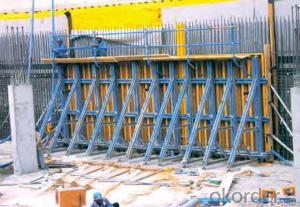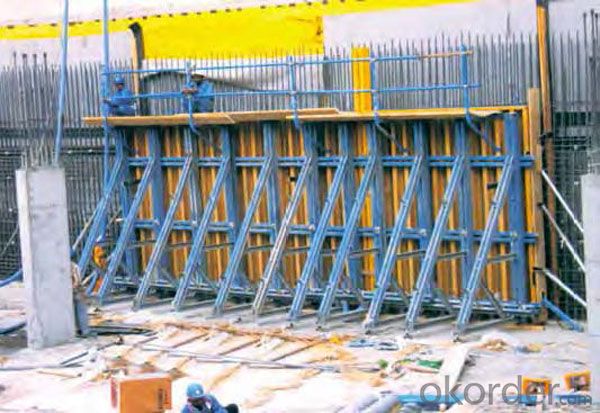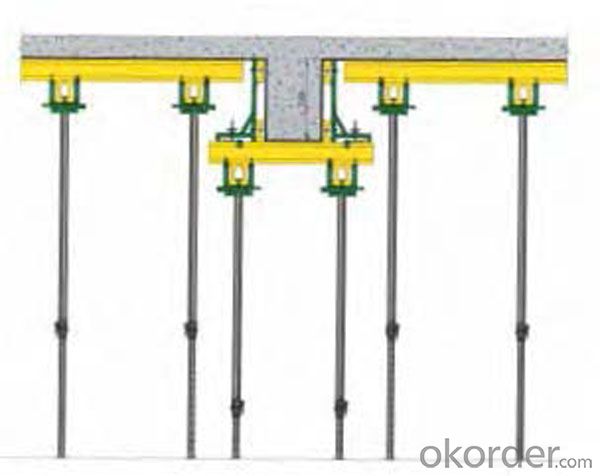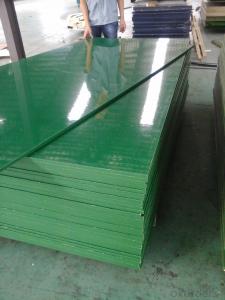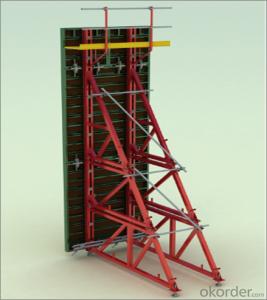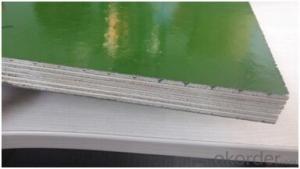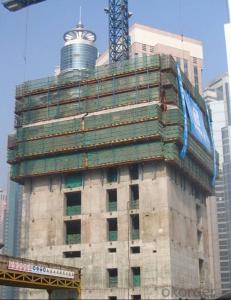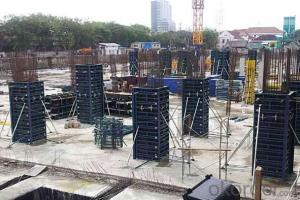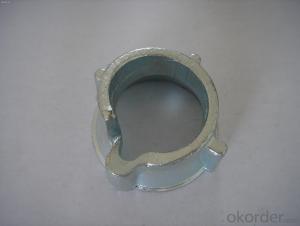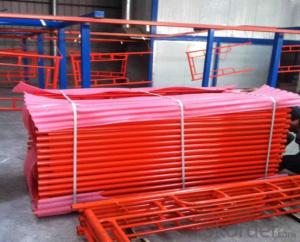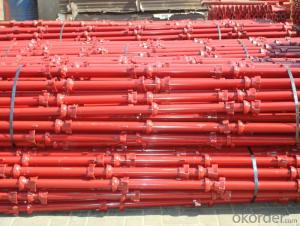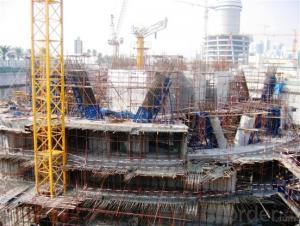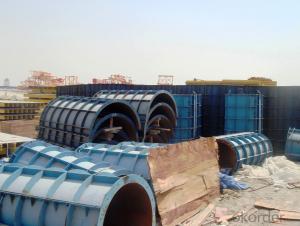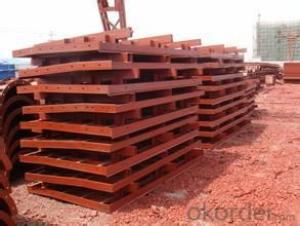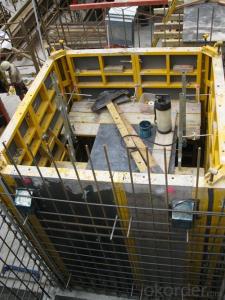Formwork Scaffolding Formwork Cuplock Scaffolding System
- Loading Port:
- Tianjin
- Payment Terms:
- TT OR LC
- Min Order Qty:
- 10000 set
- Supply Capability:
- 50000 set/month
OKorder Service Pledge
OKorder Financial Service
You Might Also Like
Plastic Formwork Concrete Formwork Circular Column Used Scaffolding Props New Design
Developing with new technology materials, steel formworks is no longer a must in construction concrete process. More and more buildings are established with plastic formworks. And workers love this new formworks much more.
The advantages of plastic formworks:
1.First of all--light
Yes it is the first advantage of plastic formwork. It wins the great praise of both contractors and workers.
The biggest panel is 120×1500px,weights 10.5kg only. It can be lift and set up by one person easily, which means there is no need for cranes on site.Saves a lot of cost and time.
2.Easy set up
Different size of panels can firmly locked by simply turn the special handles to 90 degree. The Panels has rib on the back, which makes the system need not traditional wood blocks and nails. The panels have holes to fit tie rod, guarantee the strength of the whole system.
3.Modularity
Modular formworks composed by different size of panels,the main item is 120×1500px panel,which is used for the large area of walls and slabs. There are also small size of panels like 10×1500px,20×1500pxcm,25×1500px,inner corner 20×20×1500px and outer corner 10×5×1500px.Due to the variety of panel size, the system can form almost all size walls 120×1500px panel of multiply by 125px. The material of modular formwork is PC-ABS mixed with special glass fibers which enable panels to hold high pressures.
4.Strength
The handles are made by high strength Nilon, each panel locked by at least 4 handles, which makes the whole system strong enough to pour 1000px walls.
5.Environment friendly
The system needs no cut and nail due to the variety size. Also it needs nearly no wood. The material can be recycled after broken, so it will not pollute the environment.
6.Consequent
Concrete does not stick to plastic formwork, thus the panels need no oil before using, and can be cleaned simply by water. The surface of the wall which build by modular formwork is smooth and without rework.
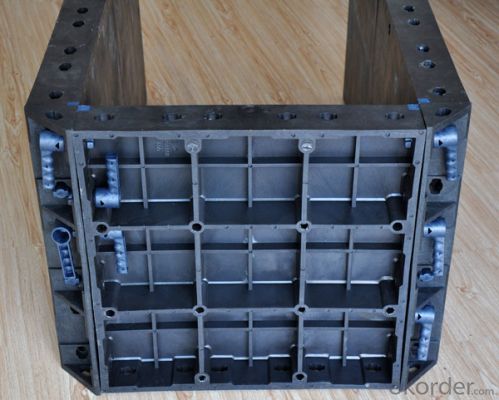
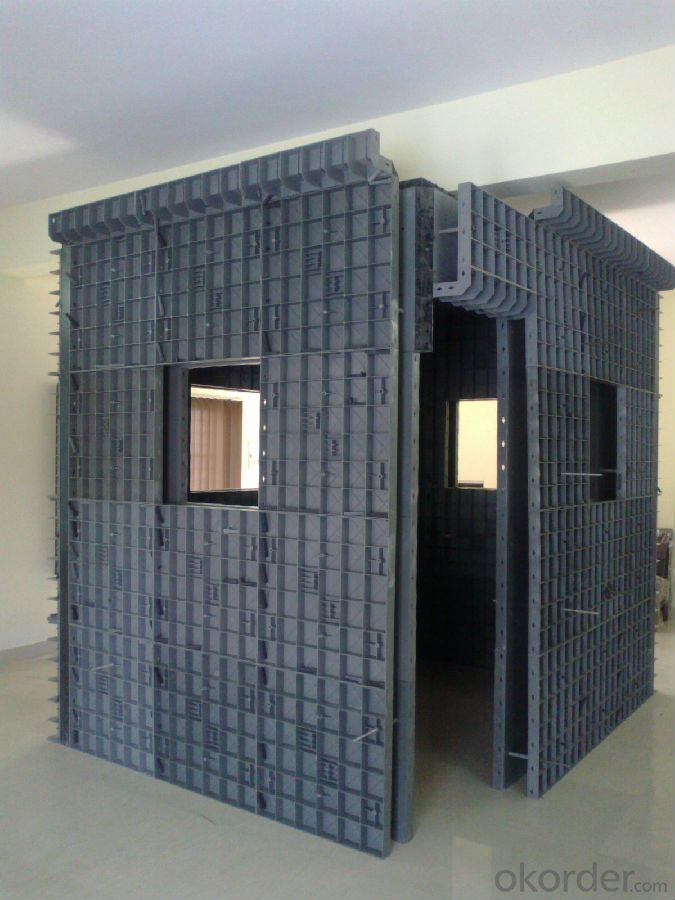
Advantage
* Good loading capacity
* Easy to assemble and dismantle
* Stable and durable thanks to its structual design & automatic welding quality
* Customized solution helps you work safe, save cost and convenient
* Excellent quality for formwork & scaffolding with wide choices
Packing
in bulk or in bundle, or as requested
Shipping
15-20 Days.
Normally small orders, it needs just 15-20 business days to the port. For goods with stock, it would be even shoter.
Other scaffolding & formwork products:
(1) Scaffolding System:
Including Ringlock Scaffolding System and accessories; Cuplock Scaffolding System and accessories; Kwikstage Scaffolding System and accessories; Haki Scaffolding System and accessories;
(2) Scaffolding Frame & Accessories:
Including Walk Through Frame Scaffolding; Ladder Frame Scaffolding; Accessories; we also can make scaffolding according to your samples or drawings.
FAQ
Why Us?
We are one of the Top 500 in the world, largest construction materials supplier in China. Also we are a state-owned company and respond to every customer with large and also small orders.
We own professional manufacturers with powerful producing capacity.
Extensive and comprehensive quality control system
Excellent products with competitive prices.
Efficient services in pre and after sale.
Full energy with affluent experience team.
- Q: Can steel frame formwork be used in combination with lightweight concrete mixes?
- Yes, steel frame formwork can be used in combination with lightweight concrete mixes. The steel frame provides the necessary structural support while the lightweight concrete mix reduces the overall weight of the formwork system. This combination allows for easier handling and installation of the formwork while still maintaining the required strength and durability.
- Q: How does steel frame formwork prevent concrete leakage?
- Steel frame formwork prevents concrete leakage through several mechanisms. Firstly, the steel frame provides a rigid structure that holds the formwork panels securely in place. This prevents any movement or displacement of the panels during the pouring and curing of concrete. As a result, there are no gaps or openings through which the concrete can escape. Secondly, steel formwork panels are typically designed with a tight fit and seamless connections. This ensures that there are no visible joints or gaps between the panels, which could potentially allow the concrete to leak through. The panels are usually connected using bolts or other mechanical fasteners to maintain a strong and watertight seal. Additionally, steel formwork panels are often coated or treated with special materials to further enhance their water resistance. This coating can be a layer of paint or a protective film applied to the surface of the panels. These coatings not only prevent concrete leakage but also help to prolong the lifespan of the formwork by protecting it from corrosion and other environmental factors. Overall, the combination of a rigid steel frame, tight panel connections, and protective coatings ensures that steel frame formwork provides an effective barrier against concrete leakage. This is crucial for achieving high-quality concrete structures and preventing any potential damage or failure due to leakage.
- Q: What are the different types of edge protection systems used with steel frame formwork?
- To ensure the safety of workers and prevent falls or accidents, various edge protection systems can be utilized in conjunction with steel frame formwork. These systems are specifically designed to establish a secure working environment by creating a barrier or guardrail around the edges of the formwork. Among the commonly employed edge protection systems for steel frame formwork is the handrail system. This particular system comprises metal or plastic handrails that are affixed to the formwork's frame. Serving as an effective barrier, these handrails effectively safeguard workers from inadvertent falls. Handrail systems are known for their simplicity in installation and flexibility to adapt to diverse formwork configurations. Another type of edge protection system is the toe board system. These horizontal barriers are installed along the lower edge of the formwork to prevent the occurrence of tools, materials, or debris falling off and potentially endangering workers below. Typically manufactured from metal or wood, toe boards can be effortlessly attached to the formwork's frame. Furthermore, certain edge protection systems incorporate mesh panels or safety nets. These systems establish a physical barrier around the perimeters of the formwork, effectively preventing accidental falls. Constructed with robust and durable materials, mesh panels or safety nets are firmly fastened to the formwork's frame. Their installation and removal are easily manageable as per the project's requirements. Finally, comprehensive edge protection systems encompass a combination of handrails, toe boards, and mesh panels or safety nets. These all-inclusive systems offer multiple layers of protection, often employed in larger construction projects or areas where risks of falls or accidents are heightened. In summary, the various types of edge protection systems utilized with steel frame formwork share the common objective of ensuring worker safety and preventing falls or accidents. The specific system employed will be contingent upon the project's demands and the level of protection necessary.
- Q: How does steel frame formwork compare to other formwork systems in terms of cost?
- Compared to timber or aluminum formwork systems, steel frame formwork typically has a higher upfront expense due to the costlier steel material. However, when looking at the overall cost throughout a project's lifespan, steel frame formwork proves to be more economically viable. The durability and reusability of steel frame formwork are major advantages. Steel is a robust material that can endure multiple uses and rough handling at construction sites. Consequently, steel formwork can be reused numerous times, reducing the need for frequent replacements and lowering long-term expenses. In addition, steel frame formwork offers greater flexibility and adaptability in comparison to other formwork systems. It can be easily customized and adjusted to meet various project requirements, resulting in reduced labor costs and improved efficiency. The ability to reuse steel formwork also decreases material costs by reducing the need to constantly purchase new formwork for each project. Moreover, steel frame formwork provides a higher level of precision and accuracy in achieving desired shapes and dimensions. This leads to fewer errors and rework, saving both time and money during the construction process. Although the initial cost of steel frame formwork may be higher, its long-term cost-effectiveness, durability, reusability, flexibility, and precision position it as a favorable choice compared to other formwork systems. It is crucial to consider the specific requirements and budget constraints of a project when assessing the cost-effectiveness of different formwork systems.
- Q: What are the common quality control inspections for steel frame formwork installations?
- Some common quality control inspections for steel frame formwork installations include checking for proper alignment and leveling of the formwork, ensuring that all connections and fastenings are secure, inspecting the quality and condition of the steel frames, verifying the accuracy of measurements and dimensions, and conducting visual inspections for any defects or damage. Additionally, inspections may also involve checking the integrity of concrete pour and the overall stability of the formwork structure.
- Q: Can steel frame formwork be used for both commercial and residential construction?
- Yes, steel frame formwork can be used for both commercial and residential construction. It is a versatile and durable system that is capable of withstanding the demands of various construction projects, regardless of size or scale.
- Q: Can steel frame formwork be used in projects with challenging weather conditions?
- Yes, steel frame formwork can be used in projects with challenging weather conditions. Steel is a durable and robust material that can withstand extreme weather conditions such as high winds, heavy rain, and freezing temperatures. It is resistant to corrosion, making it suitable for use in coastal or humid areas where there is a higher risk of rusting. Additionally, steel frame formwork systems are designed to be versatile and adjustable, allowing for easy adaptation to different project requirements and weather conditions. The strength and stability of steel formwork make it a reliable choice for construction projects in challenging weather conditions, ensuring the safety and longevity of the structure.
- Q: What are the different types of concrete release agents used with steel frame formwork?
- There are several types of concrete release agents commonly used with steel frame formwork, including petroleum-based, vegetable oil-based, water-based, and silicone-based release agents. Each type has its own unique characteristics and advantages, such as providing easy form release, preventing concrete adhesion, enhancing formwork lifespan, and minimizing surface defects on the concrete. The choice of release agent depends on factors such as the specific project requirements, environmental considerations, and the desired finish of the concrete surface.
- Q: What are the different types of steel frame formwork available in the market?
- There are several different types of steel frame formwork available in the market. Some of the most common types include: 1. Adjustable steel frame formwork: This type of formwork is designed with adjustable components that can be modified to fit different sizes and shapes of concrete structures. It is versatile and can be used for a variety of construction projects. 2. Tunnel formwork: This type of formwork is specifically designed for constructing tunnel sections. It consists of steel frames that are assembled to create a tunnel-shaped structure. Tunnel formwork is highly efficient and allows for rapid construction of tunnels. 3. Climbing formwork: Climbing formwork is a type of formwork that is used for constructing tall concrete structures, such as high-rise buildings or towers. It is designed to be easily moved vertically as the construction progresses. This type of formwork allows for faster construction and reduces the need for external scaffolding. 4. Slab formwork: Slab formwork is used for constructing concrete slabs, such as floors or ceilings. It consists of steel frames that are assembled to create a grid-like structure. Slab formwork is easy to assemble and disassemble, making it ideal for projects that require frequent changes in formwork configuration. 5. Column formwork: Column formwork is used for constructing concrete columns. It consists of steel frames that are assembled around the column shape and secured in place. This type of formwork is adjustable and can be used for different column sizes and shapes. 6. Wall formwork: Wall formwork is used for constructing concrete walls. It consists of steel frames that are assembled and secured to create a mold for the concrete. Wall formwork can be customized to fit different wall heights and thicknesses. These are just a few examples of the different types of steel frame formwork available in the market. Each type has its own advantages and is suitable for specific construction projects. The choice of formwork depends on factors such as the type of structure being built, the desired construction speed, and the budget allocated for the project.
- Q: How does steel frame formwork contribute to the overall structural integrity of a building?
- There are several ways in which the structural integrity of a building is enhanced by steel frame formwork. Firstly, the concrete pouring and curing process is supported by a strong and durable steel frame. This ensures that the formwork maintains its shape and can withstand the pressure exerted by the wet concrete. By preventing any distortion or deformation of the formwork, the concrete is poured accurately and evenly, resulting in a consistent and robust structure. Furthermore, precise alignment of the concrete elements is made possible by steel frame formwork. The steel frames can be easily adjusted and leveled, ensuring that the concrete is poured in the desired position and alignment. This is essential for maintaining the structural integrity of the building, as any misalignment or unevenness may compromise load-bearing capacity or create weak spots. Additionally, steel frame formwork offers excellent reusability and durability. Unlike traditional timber formwork, steel frames can be used repeatedly without deteriorating or losing strength. This not only saves costs and reduces waste but also ensures that the formwork remains structurally sound throughout multiple construction cycles. The durability of steel frame formwork contributes to the long-term stability and integrity of the building, as it can withstand various loads and environmental conditions without compromising its structural performance. Moreover, steel frame formwork allows for efficient construction processes. The modular design of the steel frames enables quick assembly and disassembly, reducing construction time and labor costs. This efficiency in construction contributes to the overall structural integrity of the building, as it minimizes the chances of errors or delays that could potentially compromise the structural strength. In conclusion, steel frame formwork plays a crucial role in enhancing the overall structural integrity of a building. Its robustness, precise alignment, reusability, durability, and efficiency contribute to the accurate and consistent pouring of concrete, ensuring a strong and stable structure that can withstand various loads and environmental conditions.
Send your message to us
Formwork Scaffolding Formwork Cuplock Scaffolding System
- Loading Port:
- Tianjin
- Payment Terms:
- TT OR LC
- Min Order Qty:
- 10000 set
- Supply Capability:
- 50000 set/month
OKorder Service Pledge
OKorder Financial Service
Similar products
Hot products
Hot Searches
Related keywords
